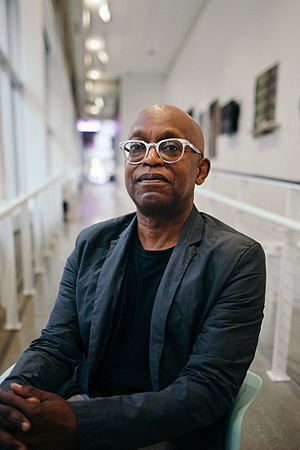Seitu Jones facts for kids
Quick facts for kids
Seitu Kenneth Jones
|
|
|---|---|

Seitu Jones
|
|
| Born | 1951 |
| Nationality | American |
| Education | M.L.S. in Environmental History and a B.S. in Landscape Design |
| Alma mater | University of Minnesota |
| Known for | Public artist |
|
Notable work
|
“Turnip Greens” Nashville Farmers Market, Nashville, TN, 2019; “At the Crossroads: A Community Meal,” Newfields, Indianapolis, IN, 2019; “Shadows at the Crossroads,” Minneapolis Sculpture Garden, MN, 2019 (collaboration with Ta-coumba T. Aiken and Soyini Guyton); “CREATE: The Community Meal,” St. Paul, MN, 2014 ; Rice Street, Dale Street and Lexington Parkway Light Rail Stations, St. Paul, MN, 2014; Storyteller’s Bench, Rondo Community Outreach Library, St. Paul, MN, 2013; Harriet Tubman, Tubman Center Alliance, Minneapolis, MN, 2003 |
| Movement | Black Arts Movement |
| Spouse(s) | Soyini Guyton |
Seitu Jones (born in 1951 in Minneapolis, Minnesota) is a talented artist. He works in many different art forms. He is also known for bringing communities together.
Jones creates large art pieces for public spaces. He also designs environments to make them better. He has made over forty big public artworks. He works both by himself and with other artists. Today, Seitu Jones lives and works in St. Paul, Minnesota.
Contents
Early Life and Artistic Beginnings
Seitu Jones was born in north Minneapolis in 1951. He went to Field Elementary School in Minneapolis. Even as a child, he knew he wanted to be an artist.
Before finishing high school, his grandfather took him to Chicago, Illinois. There, he saw the Wall of Respect. This was a famous street mural made by many artists. Seeing these large figures of Black people amazed Jones. He realized the power of "the museum of the streets." This moment inspired him to create big art pieces.
Family Inspiration
Seitu Jones finds inspiration from his great-grandfather. His great-grandfather was born into slavery. After gaining his freedom, he moved to Minnesota in 1877. He first worked as a porter at the St. James Hotel in Red Wing, Minnesota. With the money he saved, he started a farm in Rochester, Minnesota. Jones' grandmother was born on this farm.
Jones grew up in a very creative family. His aunts and uncles were painters. His father was also an artist and painter. Jones felt lucky to be surrounded by their artwork. Because of unfair treatment and racism, his father stopped pursuing art as a career. Instead, he ran a print shop from their home. His father also painted signs for Black businesses in south Minneapolis.
Seitu Jones' Art and Community Work
Much of Seitu Jones' art focuses on "placemaking." This means he creates and changes spaces. He works with the people living nearby. Together, they transform a space to give it a special feeling. Jones was also influenced by the Black Arts Movement. This movement believed artists should make their communities "more beautiful than they found it."
Jones' art has been shown in many famous places. These include the Walker Art Center and the Minneapolis Institute of Arts. His work has also been displayed at the American Craft Museum in New York. The Renwick Gallery in Washington, DC, has also featured his art.
He has also designed sets for many theaters. These include Penumbra Theatre Company and Children's Theatre Company in Minneapolis. He also worked with the Guthrie Theater.
Creating Community Meals
In 2013, Jones received a special award called the Joyce Award. This award helped him create "CREATE: The Community Meal." This was a huge dinner for 2,000 people. The meal was served at a table that was half a mile long! This project helped people think about getting healthy food.
In 2019, Jones designed "Turnip Greens." This large art piece hangs in the Nashville Farmers' Market. It shows a giant basket of spilled turnip greens. This artwork honors a popular local food. It also celebrates the farmers who grow it. The piece also brings attention to food injustice. Jones said, "There’s no way we can meet all the farmers who produce our food for us but this is a small way that we can stretch out our hands to embrace those folks."
Art Collaborations
Jones has worked with artist Ta-coumba T. Aiken on several projects. One project was "Shadows of Spirit" (1992). This art piece features human shapes made of bronze. These shapes are placed in the sidewalks of Nicollet Mall. Each shadow has poetry written by Rosemary Soyini Vinelle Guyton. The City of Minneapolis asked for this artwork. It honors important people from the area's history.
Jones and Aiken also created "Shadows at the Crossroads" (2019). These seven sculptures are in the Minneapolis Sculpture Garden. They are an extension of the Nicollet Mall project. This artwork also celebrates important individuals.
Awards and Recognitions
Seitu Jones has received many awards for his art.
- McKnight Visual Artist Fellowship, Minneapolis, Minnesota (2020)
- Grand Juried Prize, ArtPrize 9, Grand Rapids, Michigan (2017)
- McKnight Distinguished Artist Award, Minneapolis, Minnesota (2017)
- Forecast McKnight Public Art Grant, St. Paul, Minnesota (2015)
- Joyce Award, Joyce Foundation, Chicago, Illinois (2013-2014)
- Sally Ordway Irvine Award (Vision) (2006)
- Bush Leadership Fellowship (2005-2006)
- Artist-in-Residence, Harvard University (2001-2002)
- NEA/TCG Designer Fellowship (1994-1995)
- Bush Artist Fellowship (1992-1993)
- McKnight Visual Artist Fellowship (1990)
- Minnesota State Arts Board Fellowship (1990)

